
Ready to get certified?
Free CDCES Coach App

Subscribe
eNewsletter
Download
Free Med Pocket Cards
February 2025 E-Newsletter

Announcements
_________________________
- New “Front-of-Product” Label Proposed
- “Let it Flow” – Semaglutide Approved for CKD
- Marshmallows & Hope: Diabetes Camp
- 14 “Making a Difference” Scholarships – due Feb 24th
- Question of Week
- Rationale of Week
- 20% Off – Spreading the Love Sale Ends Feb 16th!
Upcoming Programs
___________________________
Happy February!
February is all about love, 💙 and that spirit shines brightly in diabetes care and education! We speak from the heart as we advocate for evidence-based care that supports well-being and transforms lives.
In recognition of these daily contributions of diabetes care and education specialists, we are delighted to announce our annual “Spreading the Love” Sale! Enjoy 20% off all our online courses, including program extensions through February 16th.
This month’s newsletter includes exciting information on a new “front-of-package” food labeling proposal that aims to provide more accurate and accessible information for consumers, before adding packaged foods to their carts.
We announce the approval of semaglutide as a first-line agent to protect renal function in people living with chronic kidney disease.
Have you ever considered volunteering at a diabetes camp? After reading this article contributed by a camper and later a diabetes nurse educator, you might be inspired to sign up for a camp near you.
DiabetesEd Services is thrilled to announce an exciting milestone—our first-ever offering of 14 Scholarships for healthcare professionals dedicated to serving under-resourced communities. This initiative is part of our Bridge Program, aimed at mentoring 1,000 new diabetes care professionals over the next ten years.
As always, test your knowledge with our Question and Rationale of the week. We hope to see you at our 3-Day Virtual DiabetesEd Training Conference in April or at a future event!
With love,
Coach Beverly, Bryanna, Tiffany, Christine, & Katarina
Ignite your passion & prepare for Diabetes Certification!
Join our Expert Team at our dynamic Virtual DiabetesEd Training Conference April 16-18th, 2025

Gain fresh insights, practical tools, and a deeper understanding of the latest in person-centered diabetes care. Our expert team brings the ADA Standards of Care to life—covering medications, behavior change, technology, and more! If you’re preparing for the CDCES or BC-ADM exam, this conference—paired with free bonus courses—serves as the ideal study companion!
With interactive co-teaching, we keep sessions engaging, relevant, and fun. Let’s learn and grow together!

Our expert team transforms complex diabetes science into clear, practical insights—keeping it real, engaging, and fun! The faculty includes:
- Diana Isaacs, PharmD, BCPS, BC-ADM, BCACP, CDCES
- Coach Beverly Thomassian, RN, MPH, CDCES, BC-ADM
- Christine Craig, MS, RD, CDCES
- 3 Days: of critical information delivered by passionate speakers in an engaging and fun format!
- 11 Bonus Online Courses: As a course attendee, you automatically receive a bonus online course bundle of 11 online courses valued at over
- e-Syllabus & Resources
Rationale of the Week | ADA 2025: Intensive Prevention for High-Risk Individuals with BMI >35 kg/m2
For last week’s practice question, we quizzed participants on what defines overbasalization according to 2025 ADA Standards? 60% of respondents chose the best answer. We want to clarify and share this important information, so you can pass it on to people living with diabetes and your colleagues, plus prepare for exam success!
Before we start though, if you don’t want any spoilers and haven’t tried the question yet, you can answer it below: Answer Question

Question:
According to ADA 2025 Standards, more intensive preventive approaches should be considered in individuals who are at particularly high risk of progression to diabetes, including individuals with BMI ≥35 kg/m2 who:
Answer Choices:
- Sit more than eight hours a day and have a sedentary lifestyle.
- Have a history of thyroid or celiac disease.
- Consume a diet with high amounts of simple carbohydrates.
- Have fasting plasma glucose of 110–125 or A1C ≥6.0%.
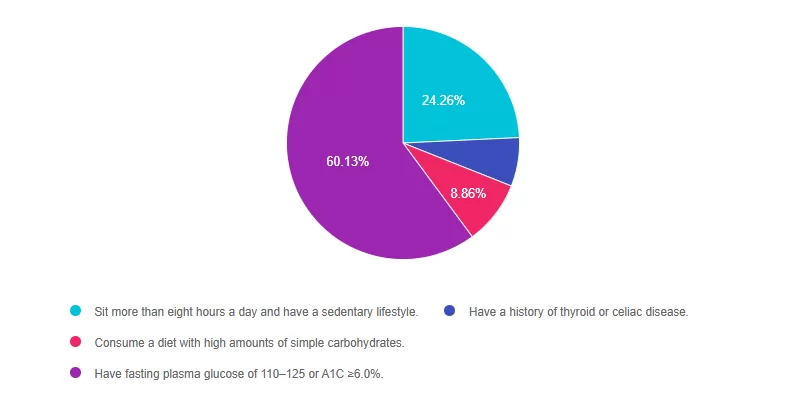
Getting to the Best Answer
Answer 1 is incorrect. 25% chose this answer, “Sit more than eight hours a day and have a sedentary lifestyle”. Although the ADA Standards recommend getting up and moving every half-hour, they don’t specify that eight hours of sitting a day qualifies a person as higher risk to progressing to diabetes.
Answer 2 is incorrect. 7% of you chose this answer “Have a history of thyroid or celiac disease”. These autoimmune conditions are more closely associated with immune mediated type 1 diabetes and do not place a person as higher risk for progression to type 2 diabetes.
Answer 3 is incorrect. About 9% of respondents chose this, “Consume a diet with high amounts of simple carbohydrates.” While eating foods rich in fiber and a variety of nutrients is important to decrease risk of diabetes, the ADA does not state that eating simple carbohydrates puts individuals in a higher risk category of progressing to diabetes.
Finally, Answer 4 is correct 60% chose this answer, “Have fasting plasma glucose of 110–125 or A1C ≥6.0%.” Great job. This is the BEST answer. According to ADA 2025 Standards, “More intensive preventive approaches should be considered in individuals who are at particularly high risk of progression to diabetes, including individuals with BMI ≥35 kg/m2, those at higher glucose levels (e.g., fasting plasma glucose 110–125 mg/dL [6.1–6.9 mmol/L], 2-h post challenge glucose 173–199 mg/dL [9.6–11.0 mmol/L], and A1C ≥6.0% [≥42 mmol/mol]), and individuals with a history of gestational diabetes mellitus.”
We hope you appreciate this week’s rationale! Thank you so much for taking the time to answer our Question of the Week and participate in this fun learning activity!
Ignite your passion & prepare for Diabetes Certification!
Join our Expert Team at our dynamic Virtual DiabetesEd Training Conference April 16-18th, 2025

Gain fresh insights, practical tools, and a deeper understanding of the latest in person-centered diabetes care. Our expert team brings the ADA Standards of Care to life—covering medications, behavior change, technology, and more! If you’re preparing for the CDCES or BC-ADM exam, this conference—paired with free bonus courses—serves as the ideal study companion!
With interactive co-teaching, we keep sessions engaging, relevant, and fun. Let’s learn and grow together!

Our expert team transforms complex diabetes science into clear, practical insights—keeping it real, engaging, and fun! The faculty includes:
- Diana Isaacs, PharmD, BCPS, BC-ADM, BCACP, CDCES
- Coach Beverly Thomassian, RN, MPH, CDCES, BC-ADM
- Christine Craig, MS, RD, CDCES
- 3 Days: of critical information delivered by passionate speakers in an engaging and fun format!
- 11 Bonus Online Courses: As a course attendee, you automatically receive a bonus online course bundle of 11 online courses valued at over
A Life with Type 1 Diabetes: My Camp Journey
by Jeannie Hickey, RN, CDE


Marshmallows and Hope: Bearskin Meadows
In 1965, when I was just 12 years old, my parents dropped me off at Bearskin Meadows, a two-week camp for kids with Type 1 diabetes. It was shortly after I had been diagnosed, and I was still adjusting to my new reality. I remember the daily routines vividly—carrying my cup of urine to the “lab,” lining up for my Regular and NPH injections twice a day, and using meal cards that followed the exchange system for servings.
But even with all that, there were moments of pure joy. I recall playing, singing around the campfire, and yes—roasting marshmallows for s’mores! (A sugary snack at a diabetes camp? Go figure!)
By the time I returned home, I felt much more comfortable with my condition and, more importantly, I felt hopeful. That experience gave me a sense of community and confidence that would shape my relationship with diabetes for years to come.
Fast forward 35 years. Now a Registered Nurse and Certified Diabetes Educator (RN, CDE), I found myself at a “Back to School” conference for parents of children with Type 1 diabetes, hosted by Diabetes Youth Families (DYF). During the event, camp counselors were leading the kids’ activities, and I recognized familiar images from the very same camp I had attended as a child. They invited me to return as a volunteer RN, offering insulin dose adjustments for a group of campers and helping with daily education alongside endocrinologists and other diabetes professionals. (And yes, there were CEUs too!)
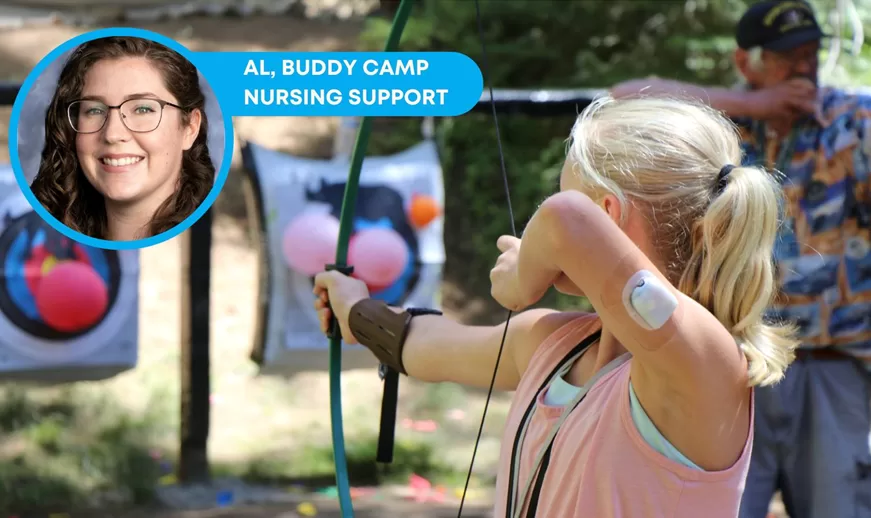

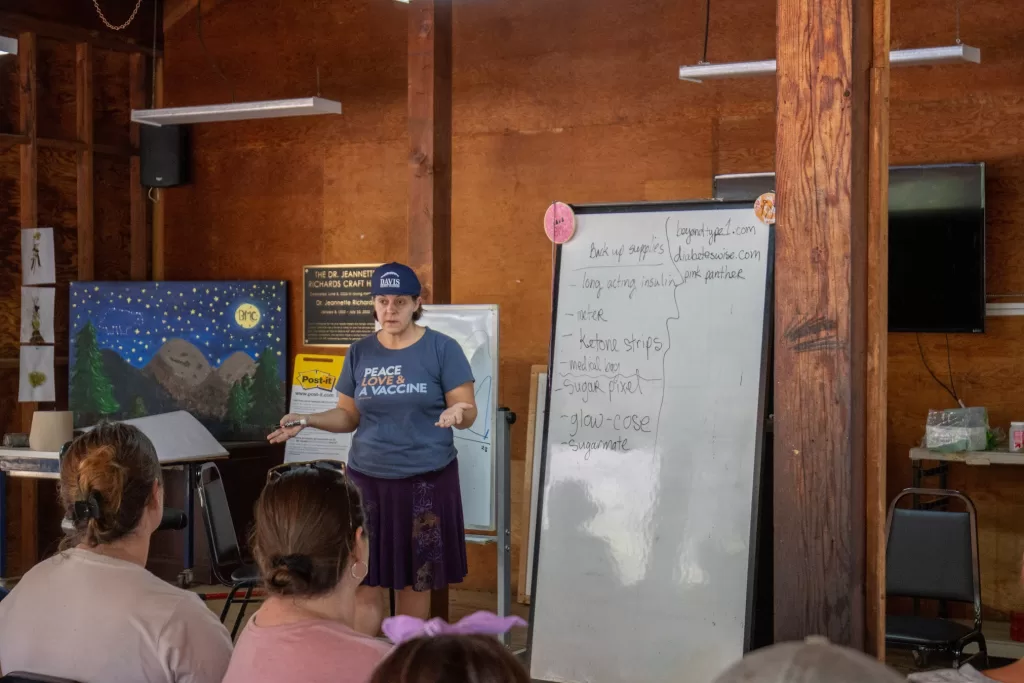
Life Changing Opportunity
That opportunity was life-changing. What started as a one-time volunteer experience quickly turned into a 21-year, part-time summer job. From my initial role as a volunteer, I eventually became the Assistant Medical Director, overseeing the medical care for kids, teens, and families during the two-month camp season. The work I did with Diabetes Youth Families was incredibly rewarding, and I continue to be inspired by the campers and their families each year.
I am thrilled to share my story and encourage you to consider signing up for this unique opportunity of volunteering at T1D camp. You get to learn about and support kids navigating type 1 while diabetes while they are having fun at camp.
Many states have camps, both independent, ADA, or through the Lions. Some offer state CEUs for your volunteer hours and the medical education presented by MDs, other RNs, RDs or Mental Health. DECA – Diabetes Education & Camping Association has a list of accredited camps to consider.
Jeannie Hickey RN, CDE (past Asst Med Dir for Bearskin Meadow Camp through Diabetes Youth Families)
T1D 60 yrs this July!!
If this is an experience you’d like to explore, there are many accredited camps and conferences available. Check out resources like Diabetes Youth Families to find a camp near you and make lasting connections with others living with Type 1 diabetes. Teen Ed Day Sponsorship Packet

What Can Camp Volunteers Expect?
While volunteering at camp your learning objectives are:
- psycho-social issues of living with diabetes
- treatment of hypoglycemia & using Glucagon
- sick day and hyperglycemia treatment
- supporting children in monitoring their blood glucose level and insulin administration
- benefits and challenges of using insulin pumps and sensors
- overall diabetes case management
- diabetes education for a variety of age groups school issues
If new to camp, you will be partnered with a physician or RN until you feel comfortable with the protocol. There will be pump savvy RNs to support & assist your learning. You will not be on your own.
You can also support your Families by learning more about camp and encouraging them to attend as a family, or send their kids (and get a week free from diabetes). See the helpful resources below.
Ignite your passion & prepare for Diabetes Certification!
Join our Expert Team at our dynamic Virtual DiabetesEd Training Conference April 16-18th, 2025

Gain fresh insights, practical tools, and a deeper understanding of the latest in person-centered diabetes care. Our expert team brings the ADA Standards of Care to life—covering medications, behavior change, technology, and more! If you’re preparing for the CDCES or BC-ADM exam, this conference—paired with free bonus courses—serves as the ideal study companion!
With interactive co-teaching, we keep sessions engaging, relevant, and fun. Let’s learn and grow together!

Our expert team transforms complex diabetes science into clear, practical insights—keeping it real, engaging, and fun! The faculty includes:
- Diana Isaacs, PharmD, BCPS, BC-ADM, BCACP, CDCES
- Coach Beverly Thomassian, RN, MPH, CDCES, BC-ADM
- Christine Craig, MS, RD, CDCES
- 3 Days: of critical information delivered by passionate speakers in an engaging and fun format!
- 11 Bonus Online Courses: As a course attendee, you automatically receive a bonus online course bundle of 11 online courses valued at over
Question of the Week | Action needed to prevent heart failure?

Adults with diabetes are at increased risk for the development of asymptomatic or symptomatic heart failure.
According to the ADA 2025 Standards of care, what action is needed to facilitate prevention of heart failure?
- Recommend the DASH Diet.
- Measure natriuretic peptide (BNP or pro-BNP).
- Assess ankle circumference at each visit.
- Recommend echocardiography after age 55.
Want to learn more about this question?
Join us live on starting Feb. 6th- March 5th, 2025 for our
Level 3
Diabetes Mastery & Cert Readiness

Ready for your certification exams? Our Level 3 course series is the final step in your exam prep, complementing our Level 1, 2, or 4 bundles. Designed for healthcare professionals preparing for diabetes certification exams in 3-6 months, this master-level series covers key topics like pharmacology, technology, MNT, and person-centered care, all based on the latest ADA Standards of Care.
Each course includes a video, podcast, practice test, and additional resources—available immediately for one full year. Boost your knowledge and confidence to succeed in your certification!
Common New Year Questions for CDCES Prep
“What Year ADA Standards Should I Study?”
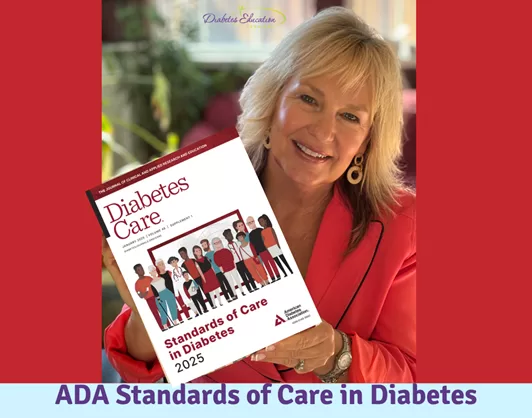 Given my seven-time experience taking the CDCES exam, I can say with complete conviction that being familiar with the American Diabetes Association (ADA) Standards of Care is one of the most important and essential strategies to prepare for exam success. More importantly, this evidence-based guidebook is crucial for providing the best clinical and person-centered care, with close attention to the Social Determinants of Health.
Given my seven-time experience taking the CDCES exam, I can say with complete conviction that being familiar with the American Diabetes Association (ADA) Standards of Care is one of the most important and essential strategies to prepare for exam success. More importantly, this evidence-based guidebook is crucial for providing the best clinical and person-centered care, with close attention to the Social Determinants of Health.
Taking CDCES in January or February 2025?
If you are taking the exam in January or February 2025 and you have already read the 2024 ADA Standards cover-to-cover, you are all set. It takes at least a year for the exam writers to include new questions culled from the ADA Standards. Having said that, if there are any critical new guidelines that impact clinical care, education, or treatment of diabetes, that content can be included in the exam that same year. From my review of the 2025 Standards, there are no critical new clinical guidelines that need immediate adoption into practice. One important caveat to consider: if you are relying on last year’s standards, make sure to read through the Summary of Revisions section included in the Standard of Care, so that you that latest information under your belt.
Taking the Exam in 2025 Sometime?
On the other hand, if you are taking the exam in 2025 and haven’t reviewed the ADA Standards in the past, I recommend a thorough review of the most recent ADA Standards. You can access the ADA Standards on our CDCES Coach App and the ADA Website at www.diabetes.org.
Short on Time?
In case of emergency, there is a shorter version of the ADA Standards called the Abridged version for Primary Care Providers that highlights critical clinical content. The abridged version is usually released in February by the ADA. It can also be used as a quick review after you have read the document in full. Again, after successfully passing the exam seven times, my advice is to be familiar with the ADA Standards of Care in its entirety.
Study Strategies from Coach Beverly
- Plan on reading one Standard a week, highlighting key content areas – you CAN do it!
- Review the most challenging Standards several times to allow the content to sink in.
- Provide a short in-service on an aspect of a Standard you found particularly difficult.
- Join our Level 2 – ADA Standards 2025 Update and Online Series, where Coach Beverly breaks down the critical content to help you focus your limited study time.
- Create old-fashioned flashcards and quiz yourself while walking.
- Join our FREE Prep for CDCES Certification Webinars.
“What Counts Toward My 1000 Hours and How Can I Accumulate Hours?”
If you are trying to accumulate practice hours, you may be wondering what counts toward the 1000 hours of Diabetes Self Management (DSME) Experience.
Below is an excerpt from the CBDCE Exam Handbook regarding what hours count towards this 1000-hour DSME requirement:
- Assessment: The participant’s DCE needs are identified. This process is led by the participant with the assessment and support of the educator.
- Education and Care Plan: The participant’s individualized education and care plan is developed. The plan reflects the participant’s self-management goals and current evidence and practice guidelines and includes criteria for evaluating outcomes.
- Interventions: The specialist delivers intervention options to assist the participant in meeting self-management goals.
- Ongoing Support: The specialist provides options for ongoing support and resources. The support option(s) is selected by the participant to best meet their self-management goals.
- Participant Progress: The specialist will monitor and communicate whether the participant is achieving their self-management goals and other outcome(s) to evaluate the effectiveness of interventions. Additional assessments are based on the participant’s needs across the lifespan.
- Documentation: The specialist documents the assessment, education plan, intervention, and outcomes in the participant’s health record.
- Services Development/Administration: Development and administrative activities performed as part of DSMES services.
Is There a Tracker to Document My Hours?
To help you keep track of your hours, we created the Diabetes Management Hours Tracker. The column “Remaining Hours Needed” is a formula that is tied to “Hours Completed” so be sure to only put numbers in the hour’s column so the formula automatically deducts those hours to get the remaining hours you need. Make sure you let your supervisor know you are tracking your hours, since they will need to attest and verify DSME hours completed.
Tracking your activities and hours consistently is key and this Hours Tracker excel sheet can help you tally your hours, while working toward your goal of becoming a CDCES.
Work Experience Hours: How To Gain Hands-On Experience
Meeting the 1,000-hour requirement for the Certified Diabetes Care and Education Specialist (CDCES) exam is achievable with a variety of approaches. The hours needed can include volunteer or paid hours. Below are some practical ways to accumulate hours if you are not able to accrue enough hours in your current work environment.
- Volunteer in Community Health Programs or Diabetes Camps
-
- Offer your expertise to local diabetes prevention or management programs, such as YMCA’s Diabetes Prevention Program, Diabetes Camps, or similar initiatives.
- Shadow a Diabetes Education Specialist in your Community
-
- Search for already existing diabetes programs in your community and volunteer to help with their diabetes program. This might even evolve into a paid position in the future.
- Join ADCES Local Networking Diabetes Groups
-
- Networking with diabetes educators in your area can lead to opportunities to gain hours and possible future employment.
- Join Diabetes Support Groups
-
- Facilitate or assist with support groups in person or online to provide guidance and share educational resources.
- Offer Educational Workshops or Webinars
-
- Create and present workshops for people with diabetes or even train other healthcare professionals about aspects of diabetes management.
- Collaborate with Pharmacies
-
- Partner with local pharmacies to provide diabetes education to people picking up diabetes-related medications or supplies.
- Participate in Health Screenings or Free Health Clinics
-
- Assist with diabetes screenings, provide educational coaching at health fairs, or sign up to provide diabetes coaching at your local free clinic.
- Support Long-Term Care Facilities
-
- Offer diabetes-related education to staff and residents in long-term care or assisted living facilities.
- Write or Develop Educational Content
-
- If you’re skilled in writing, contribute to diabetes educational materials for local papers and websites. You can count the time spent on research and content development towards your hours.
- Join our Facebook Certification Exam Study Group
- This group is great for networking, connecting with colleagues and sharing study tips.
Resources to help Prepare for CDCES Exam
- Join our annual ADA Standards of Care | 2.0 CEs Update on January 30, 2025!
- CDCES Coach App – Which includes the ADA Standards of Care, quizzes and lot so of FREE info.
- Level 2 | Standards of Care Intensive | 20+ CEs –
- Prep for CDCES Exam Resource Page
Are you Interested in Starting a Mentorship Program?
As part of our Bridge Program, Coach Beverly wants to support YOUR efforts to mentor a new generation of Diabetes Care and Education Specialists. If you are a mentor, we are offering significant discounts off of our Diabetes Boot Camp or Virtual 3 Day Program for groups of mentees who are practicing in underserved regions of our country. Please email us for more information at [email protected]
The 2025 ADA Standards of Care are here!!
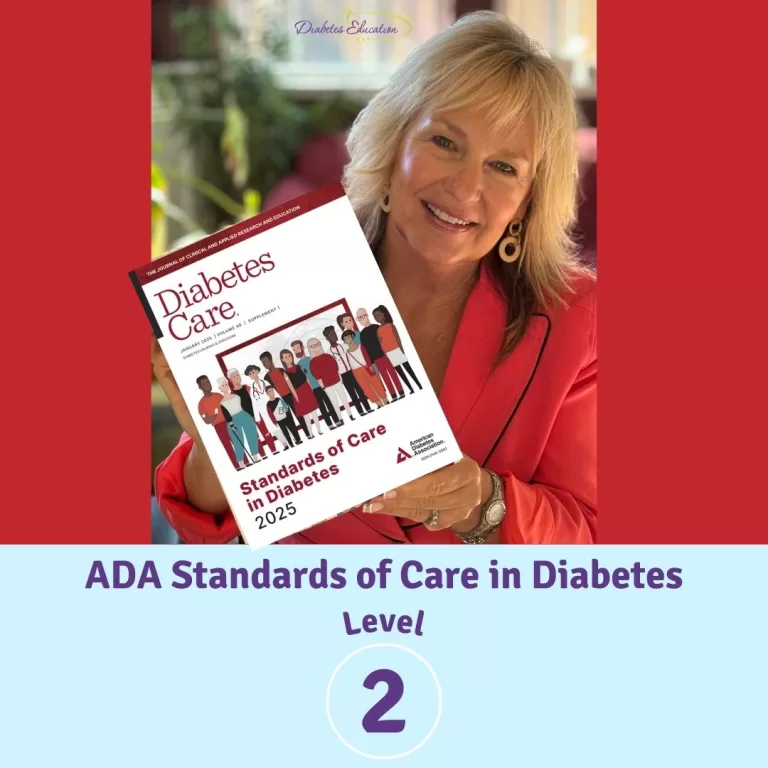
This webinar provides a comprehensive breakdown of the ADA Standards of Care, focusing on essential content for clinical practice and exam success.
This webinar is designed for healthcare professionals aiming to deepen their understanding of the ADA Standards for improved practice or preparing for the BC-ADM or CDCES certification exams.
Let it FLOW – Semaglutide Approved for Renal Protection
FDA Expands Ozempic Approval to Protect Kidney (and Heart) Health in People with Type 2 Diabetes and Chronic Kidney Disease
Last month, the U.S. Food and Drug Administration (FDA) approved Ozempic (semaglutide) to reduce the risk of worsening kidney disease, kidney failure, and cardiovascular-related death in adults with type 2 diabetes and chronic kidney disease (CKD). This decision was based on results from the FLOW phase 3 clinical trial.
This expanded approval represents a major advancement for people managing both conditions, offering an additional tool to protect kidney function and heart health.
 The Link Between Chronic Kidney Disease and Diabetes
The Link Between Chronic Kidney Disease and Diabetes
Chronic kidney disease (CKD) is a serious and prevalent condition affecting about 30% of people living with diabetes. CKD can progress over time, potentially leading to kidney failure that requires dialysis or a transplant. Additionally, individuals with both CKD and diabetes face an elevated risk of cardiovascular complications, including heart attacks and strokes.
How Ozempic Benefits Individuals with Diabetes and CKD
Semaglutide (Ozempic) is a commonly used GLP-1, that not only lowers blood glucose levels and body weight, it has also been proven to reduce the risk of major cardiovascular events in adults with type 2 diabetes.
Now, with this latest FDA approval, semaglutide is also recognized for its ability to slow kidney disease progression and lower the risk of kidney failure and cardiovascular-related deaths in people with type 2 diabetes and CKD.
The Science Behind the Approval: FLOW Trial Results
The FDA’s decision was based on the FLOW phase 3b kidney outcomes trial, which involved 3,533 adults with type 2 diabetes and CKD. The study compared the effects of once-weekly semaglutide 1.0 mg injections versus a placebo. Findings revealed a 24% reduction in the risk of kidney disease worsening, kidney failure, and cardiovascular death in participants receiving semaglutide. Due to the overwhelming efficacy, the trial was stopped early after meeting its pre-specified criteria.
Expert Insights
Dr. Richard E. Pratley, Medical Director at the AdventHealth Diabetes Institute in Orlando, FL, and Co-Chair of the FLOW Trial, emphasized the significance of this approval:
“Managing type 2 diabetes is already challenging, and chronic kidney disease adds another layer of complexity. In my practice, I see many patients with serious kidney complications—some requiring dialysis. The FDA’s decision provides new hope and an additional treatment option that can make a meaningful difference in protecting kidney function and cardiovascular health.”
What This Means for Individuals with Diabetes and CKD
For individuals living with both type 2 diabetes and CKD, semaglutide offers a new treatment option to help preserve kidney function and lower the risk of life-threatening cardiovascular events. Effectively managing both conditions can improve long-term health outcomes and quality of life.
If you are working with individuals with type 2 diabetes and CKD, initiating semaglutide early in the treatment plan can not only protect kidney health but also decrease the risk of worsening kidney function, further improving outcomes.
Conclusion
The FDA’s expanded approval of Ozempic marks a crucial milestone for people with type 2 diabetes and CKD. With strong clinical trial evidence supporting its effectiveness, this treatment provides renewed hope for those at risk of worsening kidney disease and cardiovascular complications.
See our Medication PocketCards for more information.
NEJM Article: Effects of Semaglutide on Chronic Kidney Disease in Patients with Type 2 Diabetes
Ignite your passion & prepare for Diabetes Certification!
Join our Expert Team at our dynamic Virtual DiabetesEd Training Conference April 16-18th, 2025

Gain fresh insights, practical tools, and a deeper understanding of the latest in person-centered diabetes care. Our expert team brings the ADA Standards of Care to life—covering medications, behavior change, technology, and more! If you’re preparing for the CDCES or BC-ADM exam, this conference—paired with free bonus courses—serves as the ideal study companion!
With interactive co-teaching, we keep sessions engaging, relevant, and fun. Let’s learn and grow together!

Our expert team transforms complex diabetes science into clear, practical insights—keeping it real, engaging, and fun! The faculty includes:
- Diana Isaacs, PharmD, BCPS, BC-ADM, BCACP, CDCES
- Coach Beverly Thomassian, RN, MPH, CDCES, BC-ADM
- Christine Craig, MS, RD, CDCES
- 3 Days: of critical information delivered by passionate speakers in an engaging and fun format!
- 11 Bonus Online Courses: As a course attendee, you automatically receive a bonus online course bundle of 11 online courses valued at over
Rationale of the Week | What defines overbasalization according to 2025 ADA Standards?
For last week’s practice question, we quizzed participants on what defines overbasalization according to 2025 ADA Standards?. 52% of respondents chose the best answer. We want to clarify and share this important information, so you can pass it on to people living with diabetes and your colleagues, plus prepare for exam success!
Before we start though, if you don’t want any spoilers and haven’t tried the question yet, you can answer it below: Answer Question

Question:
What defines overbasalization according to 2025 ADA Standards?
According to the new 2025 ADA Standards of Care, which of the following most accurately reflects overbasalization?
Answer Choices:
- basal insulin doses exceeding 0.5 units/kg/day
- significant bedtime-to-morning or postprandial-to-preprandial glucose differential
- low glycemic variability
- basal insulin dose exceeding 50 units twice per day
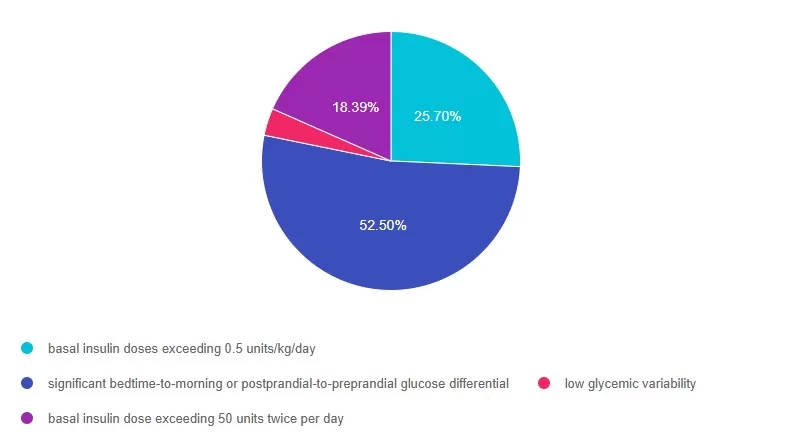
Getting to the Best Answer
Answer 1 is incorrect. 25% chose this answer: basal insulin doses exceeding 0.5 units/kg/day. This year, the ADA Recommendation was revised to remove consideration of basal insulin doses exceeding 0.5 units/kg/day as evidence of overbasalization. Instead, signs of overbasalization including significant bedtime-to-morning or postprandial-to-preprandial glucose differential, occurrences of hypoglycemia (aware or unaware), and high glycemic variability should be used.
Answer 2 is correct. 52% of you chose this answer: significant bedtime-to-morning or postprandial-to-preprandial glucose differential. GREAT JOB! In the 2025 ADA Standards (9), they define overbasalization as significant bedtime-to-morning or postprandial-to-preprandial glucose differential, occurrences of hypoglycemia (aware or unaware), and high glycemic variability.
Answer 3 is incorrect. About 18% of respondents chose this: low glycemic variability, This is a juicy and tempting answer. However, high glycemic variability (lots of ups and downs) is more closely associated with hypoglycemia.
Finally, Answer 4 is incorrect 3% chose this answer: basal insulin dose exceeding 50 units twice per day. Overbasalization is not defined by the amount of insulin used, but by the glucose response including significant bedtime-to-morning or postprandial-to-preprandial glucose differential, occurrences of hypoglycemia (aware or unaware), and high glycemic variability
We hope you appreciate this week’s rationale! Thank you so much for taking the time to answer our Question of the Week and participate in this fun learning activity!
Want to learn more about this question?
Enroll in our Level 3
Diabetes Mastery & Cert Readiness

Ready for your certification exams? Our Level 3 course series is the final step in your exam prep, complementing our Level 1, 2, or 4 bundles. Designed for healthcare professionals preparing for diabetes certification exams in 3-6 months, this master-level series covers key topics like pharmacology, technology, MNT, and person-centered care, all based on the latest ADA Standards of Care.
Each course includes a video, podcast, practice test, and additional resources—available immediately for one full year. Boost your knowledge and confidence to succeed in your certification!
Diabetes Mentorship Program Kicks-Off in Northern Cal
 Dignity Health Mercy Medical Center Redding Steps Up with a Diabetes Mentorship Program!
Dignity Health Mercy Medical Center Redding Steps Up with a Diabetes Mentorship Program!
We are thrilled to announce the launch of the Diabetes Mentorship Program at Mercy Medical Center in Redding, designed to support and guide the next generation of diabetes educators. This unique opportunity is tailored for eight motivated mentees who are eager to gain hands-on experience in diabetes care, all while learning from Janelle Revnak, MS, RDN, CDCES, an experienced diabetes care and education specialist, with 10 years practicing as an RDN and 5 years as a CDCES. Janelle is passionate about sharing her expertise with the next generation of diabetes professionals. Her extensive background in both outpatient and inpatient diabetes education will ensure that mentees receive comprehensive training and valuable insights into the world of diabetes care.
Over the course of the program, mentees will attend monthly educational sessions led by Janelle, coupled with didactic learning sessions and job shadowing, providing an immersive experience in the inpatient setting. As part of our mentoring partnership, the trainees will also have access to our Diabetes Boot Camp series. Janelle decided to start this program after realizing that the need for diabetes education in her rural community was larger than what one person could realistically deliver. She reached out and identified colleagues in her hospital who were interested upping their diabetes knowledge and improving care.
“I alone cannot change the world, but I can cast a stone across the waters to create many ripples.” – Mother Teresa
Increasing Demand for Diabetes Care and Education Specialists
As the number of people living with diabetes continues to rise, the demand for skilled diabetes educators is paramount. According to the latest CDC Data, the prevalence of diabetes has increased dramatically over the past decade, with more than 37 million Americans now living with diabetes—an increase of nearly 30% over the past 10 years. This growing population needs more than just medical care; they require specialized education and support to effectively manage their condition. Current diabetes care and education specialists (DCES) are uniquely positioned to assist in equipping future professionals with the knowledge and experience needed to meet the needs of this expanding patient population.
The mentorship program will be held once a month and is designed to create a balanced approach to learning. Mentees will dive deep into didactic topics, such as advanced diabetes management, behavior change strategies, and innovative approaches to diabetes care. In addition to classroom-style learning, they will have the opportunity to job-shadow Janelle, gaining firsthand experience in how diabetes education is applied in real-world inpatient clinical settings. This combination of theory and practice ensures mentees are well-equipped to make an impact in the field.
Participants will also have the chance to engage with a wide range of diabetes-related cases during their job shadowing. From inpatient diabetes clinical management to individualized patient education, they will develop a well-rounded understanding of the crucial role diabetes educators play in improving care outcomes while helping individuals feel emotionally supported through this challenging disease. This hands-on approach allows for active learning and real-time feedback, which is vital for shaping confident and competent DCES.
The mentorship program is not just about learning—it’s about making connections, fostering growth and building a community of passionate diabetes care professionals. We are excited to offer this incredible opportunity to those who are committed to advancing their skills and knowledge in diabetes education. Together, we can make a real difference in the lives of those living with diabetes. In the spirit of Mother Teresa, it is not one person alone that can impact the growing population affected by diabetes, but working together, we can achieve meaningful change.
If you have questions, you can reach Janelle at [email protected].
Are you Interested in Starting a Mentorship Program?
As part of our Bridge Program, Coach Beverly wants to support YOUR efforts to mentor a new generation of Diabetes Care and Education Specialists. If you are a mentor, we are offering significant discounts off of our Diabetes Boot Camp or Virtual 3 Day Program for groups of mentees who are practicing in underserved regions of our country. Please email us for more information at [email protected]
Want more expert insights & hands-on learning?
A perfect program for healthcare professionals entering the field of diabetes!
Join us for our 2025 Virtual Conference!!!
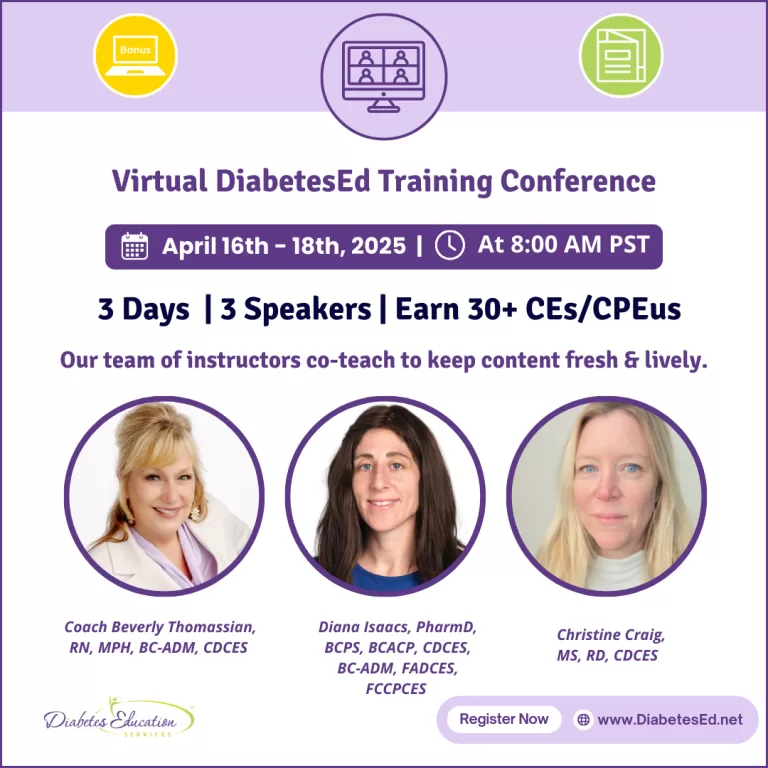
🎉 Join Our Virtual DiabetesEd Training Conference! 🎉
🗓️ Date:April 16th-18th, 2025
⏰ Time: 8:00am PST
Get ready for 2.5 days of engaging sessions on the latest in person-centered diabetes care, covering ADA Standards, medications, technology, and more! Learn from Diana Isaacs, Coach Beverly, and other experts.
💡 Can’t attend live? Access recordings, podcasts, and resources for 1 full year.
🎉 Special Offer: Register 3 or more and save $50 each!
Register now and take your diabetes expertise to the next level!







